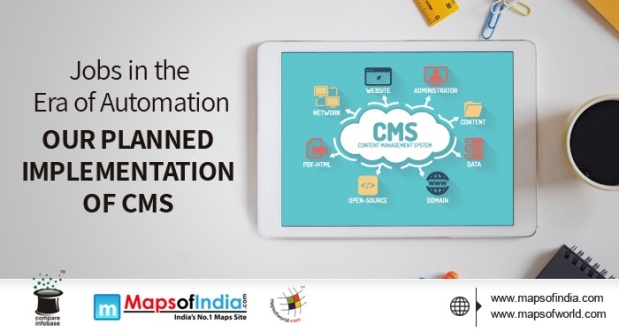
As a business, Compare Infobase relies heavily on content and its premium websites, www.Mapsofworld.com (MOW) and www.Mapsofindia.com (MOI) have thousands of pages. The amount of information its sites have draws millions of people towards them; an average of about 140,000 people on MOW and 400,000 people on MOI daily. Additionally, the organization also provides custom mapping solutions and mapping products. There are several challenges the organization is bound to face when it has such numbers to cater to, but the two predicaments we were primarily facing were:
- How to ensure that the information across the site is current, credible, and consistent?
- How the make sure that our valued resources are put into assignments which make optimum use of their skill set and know-how?
When we started our journey way back in 1998, the website www.Mapsofindia.com had some 20-odd static pages. Any change or modification, however small, had to be done across all the files manually. It was not only a tedious and time-consuming task, but also increased the probability of errors. Our tech resources had no choice but to take up this monotonous task, which was not adding any value. The site was heavily dependent on the technical resources and the overhead costs ran high. As the number of pages on the website increased, it became imperative that we introduce a solution to automate this process.
Thus, the automation of the content publishing process for our premier websites, www.MapsofIndia.com and www.Mapsofworld.com was introduced.
Our technical head, along with the team, brainstormed and researched about the solutions available in the market to address our two predicaments. That is when we stumbled upon Content Management System (CMS), a content management tool. About ten years ago, only mark-up languages were used. As coding standards developed and scripting languages came into practice, CMS was brought into existence in full form. The best part is that for using CMS one need not be a technical expert. It is a content management tool which allows the website owner to make changes at multiple locations from one point.
CMS is prevalent in all those sites which are content driven, majorly the e-commerce sites, wherein it manages the products too, and blogging as well as news specific sites. The teams reviewed the traffic statistics, the worksheets, latest studies, academic statistics, and news articles related to CMS to reach to a decision.
CMS is found in both ready-made as well as custom-made avatars. At Compare, we went ahead and explored both the variants. For our site, MyIndia we went ahead with the ready-made CMS version. MyIndia.in is a platform by Maps of India where users are invited to contribute their articles on topics such as Government, Cities, Cricket, Economy, Education, History, Movies, Politics, Travel and Society. And a customized version was adopted for our portal http://www.Writepaid.com. Writepaid is a writing community that offers writers from around the world the opportunity to publish compelling, non-fiction articles and earn residual income.
Today, the introduction of CMS is being done in phases; this is helping us fine-tune the automation while ensuring effectiveness and efficiency.
Till date almost 50% of our web pages have been made dynamic and content management system is implemented with the combined efforts of technology, UI and server support teams. There are tiny CMS being customized for the dynamic pages in MOI and MOW. Although the infrastructure cost is high, as its implementation requires a dedicated database server, but this is a one time cost.
At present, our content aggregator Writepaid and blog MyIndia are completely managed by the content team, which publishes the content directly. The requirement of HTML and design team is no longer required in the process. The valued team members can now focus on tasks which result in growth and learning of the individual, and add to the bottom line of the business.
The decision of automating the non-value-adding work has made us believe that in the era of automation, the job availability has not reduced but the job nature has witnessed a change. The team members at Compare are no longer pained by the time-consuming work, which decreases their efficiency and productivity.
We are working towards creating a workplace where employees are more contented with their jobs and they believe the work they are doing contributes, makes a difference, and provides a level of intrinsic value.